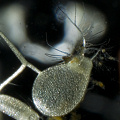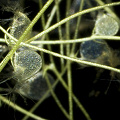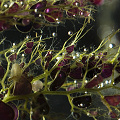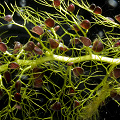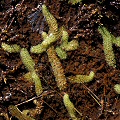Q: Exactly how do these plants capture prey? Answer #4--suction traps
A: Suction traps are found only in one genus--Utricularia.
In a suction trap, the carnivorous organ is a small pouch, ranging in size from a pin head to your littlest fingernail.
This pouch is underwater, either in open water, or in waterlogged
soils. The bladder walls are flexible, but at rest bulge outwards like an overstuffed pita bread sandwich. The trap prepares
itself for hunting by pumping fluid out of its interior by means of specialized bifid and quadrifid glands. Soon the walls of the
bladder are puckered inwards under the strain.
Prey wander up to the bladder. It is unknown if the bladder actually attracts prey chemically, or if the prey find the algae
growing on the trap enticing, or if there is no attraction at all and the bladder just relies upon the occasional blundering of
foraging creatures.
But when the creatures bump into the hairs near one end of the bladder, they initiate something marvelous. A trap door opens at
the end of the bladder, and water is allowed to rush into the bladder, replacing the water that was pumped out previously.
The little organism is swept along with the rush, and is propelled into the bladder. Digestive enzymes are released and the
prey is consumed.
A vast number of aspects of the bladder trap is not understood. For example, is the trap a carefully balanced mechanism that is
opened by the creature bumping into the door, or does the trap door have some kind of active mechanism like a turgor pressure
change to make it even more sensitive? A 2006 study suggests that at least some traps are triggered this way...
The traps of many species are often brilliantly coloured. But most tiny aquatic organisms cannot see well, so why are the traps
so colorful?
How suction traps evolved is a matter of great uncertainty, but that is not to say that it confounds evolutionary theory. It is
easy to develop plausible hypotheses of how they could have evolved--we just don't know if such theories are right.
I suspect that the bladders of these
plants evolved from a passive trapping system. A hollow pouch might capture prey, especially if adorned with inward-pointing
hairs. In order to prevent diffusion losses of valuable nutrients, the quadrifid glands might have developed to keep fluid flowing
into the traps by pumping water through the trap walls. A simplified trap door--perhaps beginning as an entryway constriction (as
in a lobster pot) might have functioned as another way to retain those valuable nutrients. Once these rudimentary organs were
in place, further evolutionary pressures could have refined their structures.
This trapping system is as mysterious as it is wonderful!
Page citations: Lloyd, F.E. 1942; Reifenrath, K. et al. 2006;
Rice, B.A. 2006a.
